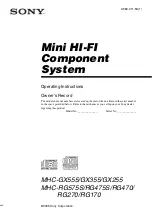
SD8 Features
The Samson SD8 utilizes state-of-the-art technology in integrated mixer/amplifier
design. Here are some of its main features:
• Convenient carrying handle and supplied standard 19" rack ears (the SD8
takes just four rack spaces) allows easy integration into any setup.
• Eight independent channels, with both mic and line inputs for each channel.
This allows you to blend together a variety of source signals, including
dynamic or condenser microphones, keyboards, CD/tape players, etc.
Standard XLR mic connectors (for microphone inputs) and electronically
balanced 1/4" jacks (for line-level inputs) are provided for each channel;
in addition, there is a dedicated stereo CD/Tape input that provides dual
phono (RCA) jacks.
• Full stereo control, with continuously adjustable Pan controls for each
channel that enable you to place each input signal independently in the
left-right plane.
• Power to spare—a full 250 watts per channel into four ohms. Any standard
speaker cabinets (four, eight, or sixteen ohms) can be connected to the four
rear-panel 1/4" speaker output jacks.
• A built-in Zoom Digital Signal Processor allows you to add a wide variety
of professional-quality effects without having to use an expensive external
signal processor. A front-panel DSP Mix Level control allows you to
precisely define the amount of effects to be blended into the signal.
• Independent three-band equalization for each channel, enabling you to
shape the sound of your input signal sources. In addition, a ten-band
graphic master equalizer allows you to “tune” the output of the SD8 to the
particular room environment you are in. This can be particularly useful for
eliminating ringing or feedback problems.
• Continuously adjustable wide-range input Trim and Level controls for
each channel allow you to precisely set the correct input and output gain
structure.
• Peak LEDs for each channel show you at a glance when an input signal is
on the verge of overloading. Other front-panel LEDs show the current status
of the amplifier’s protection relay circuitry and whether or not phantom power
is being applied to attached microphones.
• Two Aux sends per channel (one pre-fade and the other post-fade) allow
you to route multiple signals to the internal DSP, to a dedicated Monitor
output, or to external signal processors. The Monitor output enables you to
set up an onstage monitor mix that is independent of the main house mix.
A separate Monitor level control is provided on the front panel.
• Two Aux returns—with a dedicated front-panel Aux return level control—give
you the ability to blend in the return signal from external signal processors or
other line-level devices without having to utilize input channels.
• A phantom power switch enables you to use the SD8 with high-quality
condenser microphones or active DI boxes. When turned on, 48 volts of
phantom power is provided to the mic connectors of all input channels.
2






































